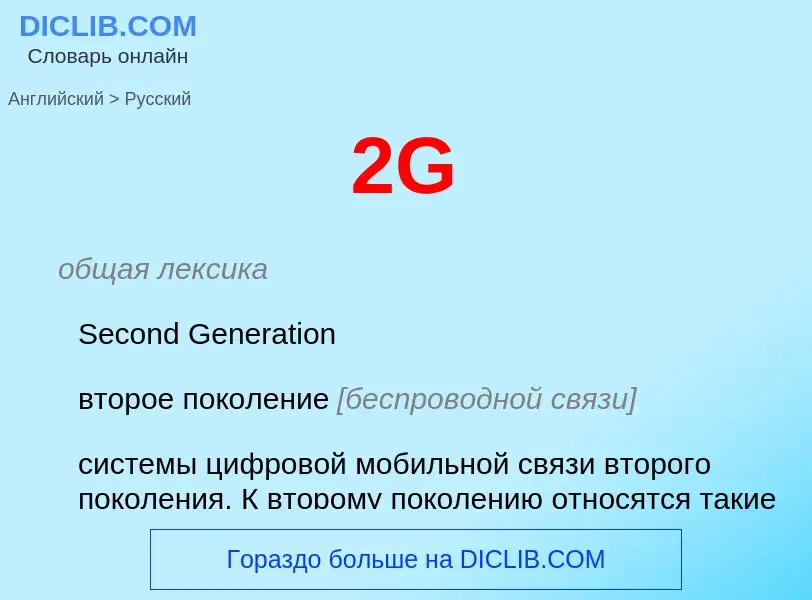Tradução e análise de palavras por inteligência artificial
Nesta página você pode obter uma análise detalhada de uma palavra ou frase, produzida usando a melhor tecnologia de inteligência artificial até o momento:
- como a palavra é usada
- frequência de uso
- é usado com mais frequência na fala oral ou escrita
- opções de tradução de palavras
- exemplos de uso (várias frases com tradução)
- etimologia
2G - tradução para russo
общая лексика
Second Generation
второе поколение [беспроводной связи]
системы цифровой мобильной связи второго поколения. К второму поколению относятся такие технологии и стандарты сетей связи, как CDMA, D-AMPS, GSM
общая лексика
(Global System for Mobile Communications) глобальная система связи с подвижными объектами
система (и стандарт) цифровой сотовой связи в Европе её аналог в США
(grams per square metre) граммов на квадратный метр, г/м2
единица измерения плотности бумаги
Definição
Wikipédia
2G is a short notation for second-generation cellular network, a group of technology standards employed for cellular networks. 2G was commercially launched on the GSM standard in Finland by Radiolinja (now part of Elisa Oyj) in 1991. After 2G was launched, the previous mobile wireless network systems were retroactively dubbed 1G. While radio signals on 1G networks are analog, radio signals on 2G networks are digital, though both systems use digital signaling to connect cellular radio towers to the rest of the mobile network system.
The most common 2G technology was the time-division multiple access (TDMA)-based GSM standard, used in most of the world outside Japan. In North America, Digital AMPS (IS-54 and IS-136) and cdmaOne (IS-95) were dominant, but GSM was also used. In Japan the ubiquitous system was Personal Digital Cellular (PDC) though another, Personal Handy-phone System (PHS), also existed.
Three primary benefits of 2G networks over their 1G predecessors were:
- Digitally encrypted phone conversations, at least between the mobile phone and the cellular base station but not necessarily in the rest of the network.
- Significantly more efficient use of the radio frequency spectrum enabling more users per frequency band.
- Data services for mobile, starting with SMS text messages then expanding to Multimedia Messaging Service (MMS).
With General Packet Radio Service (GPRS), 2G offers a theoretical maximum transfer speed of 40 kbit/s (5 kB/s). With EDGE (Enhanced Data Rates for GSM Evolution), there is a theoretical maximum transfer speed of 384 kbit/s (48 kB/s).



![GSM [[cell site]] antennas in the [[Deutsches Museum]], [[Munich]], [[Germany]] GSM [[cell site]] antennas in the [[Deutsches Museum]], [[Munich]], [[Germany]]](https://commons.wikimedia.org/wiki/Special:FilePath/Kathrein antenna.jpg?width=200)

